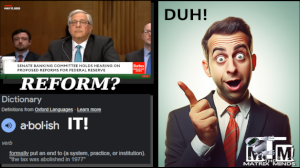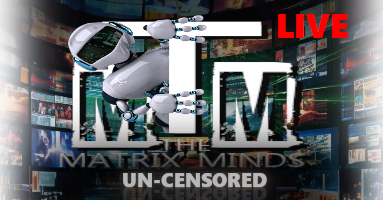 The Federal Reserve, despite its significant role in the United States’ financial system, has faced criticism and calls for its abolition over the years. Proponents argue that the Fed’s existence is unnecessary and that its powers should be returned to the free market. This article explores some arguments advocating for the abolition of the Federal Reserve and examines the notion that it is not needed in today’s economic landscape.
The Federal Reserve, despite its significant role in the United States’ financial system, has faced criticism and calls for its abolition over the years. Proponents argue that the Fed’s existence is unnecessary and that its powers should be returned to the free market. This article explores some arguments advocating for the abolition of the Federal Reserve and examines the notion that it is not needed in today’s economic landscape.
- Lack of Transparency and Accountability:
One of the primary concerns raised by critics of the Federal Reserve is the lack of transparency and accountability in its decision-making processes. The Fed’s operations are often shrouded in secrecy, with limited public access to important discussions and policy deliberations. Critics argue that this lack of transparency undermines the principles of democratic governance and limits public scrutiny of a powerful institution.
- Monetary Manipulation and Distorted Markets:
Another argument against the Federal Reserve is that its monetary policies, including interest rate adjustments and quantitative easing, can lead to market distortions and economic imbalances. Critics contend that the central bank’s interventions in the economy often result in unintended consequences, such as asset bubbles, misallocation of resources, and inflationary pressures. They argue that a free-market approach, with minimal government intervention, would allow for more efficient and natural market adjustments.
- Business Cycle Manipulation:
Critics of the Federal Reserve assert that the central bank’s attempts to manage the business cycle through monetary policy are futile and even harmful. They argue that the Fed’s actions, such as lowering interest rates during economic downturns, may create artificial booms and prolong economic recessions. They contend that market forces, without central bank interference, would lead to more sustainable and self-correcting economic cycles.
- Risk of Moral Hazard:
The existence of the Federal Reserve, with its ability to act as a lender of last resort, has been criticized for creating a moral hazard. Critics argue that the perception of a safety net provided by the central bank encourages excessive risk-taking by financial institutions, as they believe they will be bailed out in times of crisis. This, in turn, can lead to the accumulation of systemic risks and the potential for future financial instability.
- Potential for Political Manipulation:
Skeptics of the Federal Reserve express concerns about the potential for political influence on monetary policy decisions. While the Fed is designed to operate independently, critics argue that political pressures and considerations may still impact its actions, particularly during times of economic or political uncertainty. They contend that a truly free-market approach to monetary policy would remove the risk of undue political interference.
The arguments advocating for the abolition of the Federal Reserve are rooted in concerns about transparency, accountability, market distortions, and potential political manipulation. Critics argue that a free-market approach to monetary policy and banking would lead to greater economic efficiency, market stability, and individual freedom. However, it is essential to recognize that the Federal Reserve was created to address specific economic challenges and promote financial stability. The ongoing debate surrounding its necessity highlights the complex and nuanced nature of monetary policy and the role of central banks in modern economies.
The Federal Reserve: Tracing its Origins and Debunking its “Federal” Label
The Federal Reserve System, commonly known as the Fed, plays a pivotal role in the United States’ financial landscape. Established over a century ago, the Fed has been instrumental in shaping monetary policy, regulating banks, and maintaining the stability of the nation’s economy. Despite its name, the Federal Reserve is not a government agency but rather a quasi-public entity with a complex history and structure. This article delves into the origins of the Federal Reserve and explores why it is often described as not truly “federal.”
Origins of the Federal Reserve:
In the late 19th and early 20th centuries, the United States experienced a series of financial panics and banking crises that highlighted the need for a more stable and flexible banking system. This led to the formation of the Federal Reserve System, which was established by an act of Congress and signed into law by President Woodrow Wilson on December 23, 1913.
Structure of the Federal Reserve:
The Federal Reserve System consists of several components, including the Board of Governors, the Federal Open Market Committee (FOMC), and the twelve regional Federal Reserve Banks. The Board of Governors, headquartered in Washington, D.C., consists of seven members appointed by the President and confirmed by the Senate. These governors oversee and formulate the nation’s monetary policy.
The Federal Open Market Committee is the body responsible for conducting open market operations, such as buying and selling government securities, to influence interest rates and maintain price stability. It comprises the seven members of the Board of Governors and five presidents of the regional Federal Reserve Banks.
The twelve regional Federal Reserve Banks, located in major cities across the country, act as the operating arms of the Federal Reserve. They provide banking services to depository institutions, serve as the primary regulators for commercial banks, and play a crucial role in gathering economic data.
The “Not Federal” Label:
Despite its name, the Federal Reserve is not a government agency. Instead, it is an independent entity created by Congress and subject to congressional oversight. One of the reasons it is often described as not truly “federal” is that it operates with a significant degree of autonomy from direct political influence. This independence is meant to shield the Fed from short-term political pressures and allow it to make decisions based on economic considerations.
Additionally, the regional Federal Reserve Banks are not owned by the federal government but rather by member banks within their respective districts. These member banks hold shares in the regional Federal Reserve Banks and have a say in their governance. However, the Board of Governors and the appointment of the Federal Reserve Chair are subject to presidential nomination and Senate confirmation processes, which provide some level of government influence.
The Federal Reserve System, created in response to financial crises, has evolved into a complex and vital institution within the U.S. financial system. While its name suggests a direct affiliation with the federal government, it is crucial to understand that the Federal Reserve is not a government agency in the traditional sense. Rather, it is an independent entity designed to carry out monetary policy and promote the stability of the nation’s economy. By maintaining a level of autonomy, the Federal Reserve seeks to balance its responsibilities and insulate itself from immediate political influences to make decisions in the best long-term interest of the country’s economy.




Leave a Reply
Want to join the discussion?Feel free to contribute!